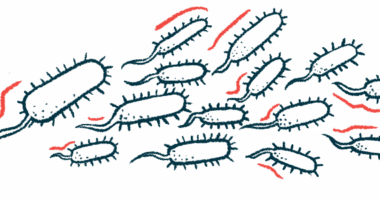
Rituximab for cold agglutinin disease
Last updated July 15, 2025, by Lindsey Shapiro, PhD

What is rituximab for cold agglutinin disease?
Rituximab is an antibody-based therapy approved in the U.S. for certain blood cancers and autoimmune diseases. Although not specifically approved for cold agglutinin disease (CAD), it is considered a first-line treatment for CAD patients who require medication, and is also used off-label to treat CAD relapses. It may be used alone or combined with other therapies.
CAD is a rare autoimmune disease in which immune B-cells mistakenly produce self-reactive antibodies, called cold agglutinins, that bind to healthy red blood cells at cold temperatures and lead to their destruction (hemolysis).
Rituximab is designed to bind to a protein called CD20 on B-cell surfaces, marking them for destruction. Lower B-cell counts are expected to reduce cold agglutinin production, ultimately preventing hemolysis and easing CAD symptoms.
In CAD, rituximab is given via intravenous (into-the-vein) infusions, a formulation sold in the U.S. by Biogen and Genentech under the brand name Rituxan and by Roche in Europe as MabThera. Also available are several biosimilars, which are highly similar, and clinically equivalent in terms of safety and effectiveness, to the brand name medication, and typically sold at lower prices.
Therapy snapshot
| Treatment name: | Rituximab |
| Administration: | Used in CAD as intravenous infusions |
| Clinical testing: | Tested in multiple Phase 2 studies involving people with CAD |
How is rituximab administered in cold agglutinin disease?
Rituximab is administered to people with CAD via intravenous infusions, but because it is not approved for the rare autoimmune disease, there is no specific treatment regimen.
When used alone, rituximab is commonly given as a course of four once-weekly infusions, at a dose of 375 mg per square meter of body surface area, over a one-month period. An additional course may later be given as needed based on a person’s response.
Different regimens may be used when rituximab is combined with other treatments. For example, when combined with the chemotherapy agents bendamustine or fludarabine, rituximab is often given monthly on the first day of each four-week cycle, with a standard course involving four cycles.

Rituximab in cold agglutinin disease clinical trials
Several small Phase 2 clinical trials have evaluated rituximab’s safety and efficacy in adults with CAD, generally showing that the therapy, used either alone or in combination with other agents, can reduce laboratory and clinical indicators of disease severity. No large-scale, placebo-controlled Phase 3 trials have tested rituximab in CAD patients to date.
- In a Phase 2 trial, around half of the 27 participants showed at least a partial treatment response after a single course of rituximab, although complete responses — where there are no signs of the disease — were rare. Patients typically started responding to treatment within a few months, but responses declined within a year, and relapses were frequent thereafter. Similar findings were reported for a similar, separate Phase 2 study that involved 20 adults with CAD.
- A Phase 2 study (NCT00373594) that tested a combination of rituximab and fludarabine in 29 CAD patients showed that about half experienced a partial response and nearly a quarter achieved a complete response. The estimated median response duration was more than five years.
- A combination regimen of rituximab and bendamustine was tested in a Phase 2 trial (NCT02689986). There, 40% of the 45 participants achieved a complete response to treatment and 31% had a partial response, with a median response duration of a little over 2.5 years.
A couple of small Phase 2 pilot studies, involving people with CAD and other related conditions, tested low doses of rituximab.
- One of such studies (NCT01345708) showed that four weekly infusions of 100 mg of rituximab, combined with the corticosteroid prednisone, resulted in a response rate of about 55% among CAD patients, with 40% of patients being free from relapses two years after treatment.
- The other trial (EudraCT 2016-002478-11) demonstrated that a dose of 5 mg per square meter, given once every three weeks, as well as regimens of fixed doses every four to 12 weeks, led to rapid B-cell depletion. However, this was not uniformly sustained over time across participants, and none of the low-dose regimens were deemed effective.
Rituximab side effects in cold agglutinin disease
The specific side effect profile of rituximab in CAD is not fully established, and may depend on the specific regimen used. Some possible side effects of rituximab include:
- infusion-related reactions, such as fever, chills, hives, low blood pressure, and swelling
- infections
- low blood cell counts.
Additional side effects may also be possible when rituximab is combined with chemotherapy agents. Patients should talk with their physicians about what to expect with their specific treatment regimen.
For its approved indications, rituximab’s prescribing information comes with a boxed warning for rare but potentially fatal complications:
- severe infusion-related reactions
- severe reactions affecting the skin or mucus membranes
- reactivation of the hepatitis B virus, which can lead to liver failure, and death
- progressive multifocal leukoencephalopathy, a rare and fatal brain infection.
Patients should let a doctor know if they experience any new or unexpected side effects when treated with rituximab.
Cold Agglutinin Disease News is strictly a news and information website about the disease. It does not provide medical advice, diagnosis, or treatment. This content is not intended to be a substitute for professional medical advice, diagnosis, or treatment. Always seek the advice of your physician or other qualified health provider with any questions you may have regarding a medical condition. Never disregard professional medical advice or delay in seeking it because of something you have read on this website.
Recent Posts
- Oral therapy iptacopan eases anemia in CAD patients: Small trial
- When living with CAD, even a short trip can be a nightmare
- Real-world study confirms long-term safety of Enjaymo for CAD
- After months of fatigue, feeling better is what I want for Christmas
- Man’s case shows bacterial lung infection can ‘provoke’ clots, CAD
- Living with cold agglutinin disease involves cruel curveballs
- Gastric lymphoma found to be hidden cause of refractory CAD
- New CAD treatments, like reading progress, prove growth is possible
- ANX1502 proof-of-concept trial to wrap up next year, Annexon says
- What if Sadie Hawkins Day made me the doctor?


